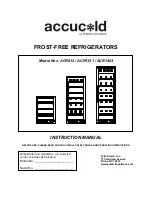
en
26
Note the chill zones in the
refrigerator compartment
The air circulation in the refrigerator
compartment creates different chill
zones:
■
The coldest zones are on the rear
panel and in the delicatessen
containers. Fig.
3
■
Warmest zone is at the very top
of the door.
Note
Store e.g. hard cheese and butter
in the warmest zone. Cheese can then
continue to release its flavour and
the butter will still be easy to spread.
The “cool-fresh”
compartment
The temperature in the fridge is about
0 °C. The low temperature and the
optimum moisture provide ideal storage
conditions for fresh food.
Food can be kept fresh up to three times
longer in the “cool-fresh” compartment
than in the normal cooling zone – for
even longer freshness, nutrient retention
and flavour.
“Cool-fresh” container
Fig.
1
/18
The “cool-fresh” container has
a temperature of almost 0 °C and
approx. 50 % air humidity.
This storage climate offers ideal
conditions for storing fish, meat,
sausage, cheese and milk.
Humidity container
Fig.
1
/20
The humidity container is covered with
a special filter which optimises retention
of the air humidity in the storage
compartment. As a result, there is up
to 95 % air humidity in the humidity
container, depending on the amount of
products put in. This storage climate
offers ideal conditions for fresh fruit,
salad greens, vegetables, herbs
or mushrooms.
Notes
■
Fruit sensitive to cold (e.g. pineapple,
banana, papaya and citrus fruit) and
vegetables sensitive to cold (e.g.
aubergines, cucumbers, zucchini,
peppers, tomatoes and potatoes)
should be stored outside the
refrigerator at temperatures of approx.
+8 °C to +12 °C for optimum
preservation of quality and flavour.
■
Condensation may form in the
humidity container depending on the
type and quantity of products stored.
Remove condensation with a dry
cloth.
Foods suitable for “cool-fresh”
container:
In the “cool-fresh” container:
Fig.
1
/18
■
Fish, seafood, meat, sausage, dairy
products, ready meals.
In the humidity container:
Fig.
1
/20
■
Vegetables (e.g. carrots, asparagus,
celery, leeks, beetroot, mushrooms,
brassicas such as broccoli,
cauliflower, Brussels sprouts, kohlrabi)
■
Salad greens (e.g. lamb’s lettuce,
iceberg lettuce, chicory, lettuce)
Summary of Contents for K811 series
Page 2: ......
Page 3: ......
Page 4: ......
Page 5: ......
Page 6: ......
Page 7: ......
Page 8: ......
Page 9: ......
Page 10: ......
Page 11: ......
Page 12: ......
Page 13: ......
Page 14: ......
Page 15: ......
Page 16: ......
Page 17: ......
Page 18: ......
Page 19: ......
Page 20: ......
Page 21: ......
Page 22: ......
Page 23: ......
Page 24: ......
Page 25: ......
Page 26: ......
Page 27: ......
Page 28: ......
Page 29: ......
Page 30: ......
Page 31: ......
Page 32: ......
Page 33: ......
Page 34: ......
Page 35: ......
Page 36: ......
Page 37: ......
Page 38: ......
Page 39: ......
Page 40: ......
Page 41: ......
Page 42: ......
Page 43: ......
Page 44: ......
Page 45: ......
Page 46: ......
Page 47: ......
Page 48: ......
Page 49: ......
Page 50: ......
Page 51: ......
Page 52: ......
Page 53: ......
Page 54: ......
Page 55: ......
Page 56: ......
Page 57: ......
Page 58: ......
Page 59: ......
Page 60: ......
Page 61: ......
Page 62: ......
Page 63: ......
Page 64: ......
Page 65: ......
Page 66: ......
Page 67: ......
Page 68: ......
Page 69: ......
Page 70: ......
Page 71: ......
Page 72: ......
Page 73: ......
Page 74: ......
Page 75: ......
Page 76: ......
Page 77: ......
Page 78: ......
Page 79: ......
Page 80: ......
Page 81: ......
Page 82: ......
Page 83: ......
Page 84: ...9000407988 9411 de en fr it nl...
















































